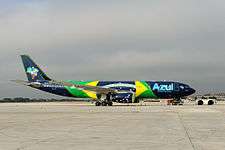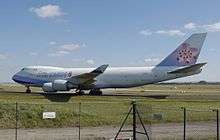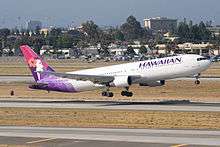List of airline liveries and logos
The aircraft liveries and logos of airlines are used to provide distinctive branding for corporate and commercial reasons. They also have to combine powerful symbols of national identity while being acceptable to an international market.[1]
National flag, symbol, or elements thereof


- Aeroflot: National flag, with traditional winged hammer and sickle used on fuselage. New livery adopted in 2003.
- Air Algérie: The company logo is a swallow, which is the national bird of Algeria.
- Air Koryo: Features national colours on the livery and flag on the tail
- AirAsia: Logotype AirAsia.com.
- Air Belgium: National flag on tail and fuselage. On the tail, the logotype, a crowned AB, accompanies the flag.
- Air Canada: Blue aircraft, with the name AIR CANADA and a stylized maple leaf on the front area of the fuselage, directly behind the cockpit, plus a maple leaf on the tail. In 2017, a new livery consisting of a white fuselage with a black underside, lettering and tail with red maple leaf logos on the engines, fuselage and tail was introduced. The new livery most notably featured a black surrounding of the cockpit windows.
- Air France: National flag, formed as several sliced parallel lines of varying widths.
- Air India: Flying swan with the Ashok Chakra.
- Air Malta: Maltese cross.

- Air Namibia: Namibian flag
- Air Puerto Rico: The Puerto Rican flag inside a sun.
- Air Serbia: logo is a stylized double-headed eagle inspired by the Serbian coat-of-arms.
- Alitalia: National color flag in the "A" logo on the tail and in all plane.
- All Nippon Airways: The Logotype "ANA".
- American Airlines: Highly stylized national flag on the tail, with the upgraded eagle design near the front exit doors. New livery adopted in February 2013.
- Austrian Airlines: Red-white-red tailfin with chevron (symbolizing an airplane taking off) with drop shadow added.
- Azul Linhas Aéreas Brasileiras: Brazilian flag carrier.

- British Airways: Britain's Flag carrier shows a section of the British Union Flag on the aircraft tail. Some aircraft feature the Union Jack under the nose.
- Bulgaria Air: Bulgarian flag used on the tail.
- Cathay Dragon: A brush-stroke logo dubbed the "brush wing" represents a bird in flight through white Chinese calligraphy stroke on a red background, but it has a dragon from dragonair logo between front door and window cockpit.
- Cathay Pacific: A brush-stroke logo dubbed the "brush wing" represents a bird in flight through white Chinese calligraphy stroke on a green background.
- China Airlines: The pink plum blossom is the national flower Republic of China (Taiwan) and is the livery for this flag carrier.
- Continental Airlines and new livery for United Airlines: A globe, indicative of the wide-ranging destinations available, initially to counteract Continental's possibly geographically restrictive name.
- Croatia Airlines: Part of the airline's logo consisting of checkered design pattern originating from the coat of arms of Croatia.
- EgyptAir: The airline's logo is Horus, the sky deity in ancient Egyptian mythology, usually depicted as a falcon or a man with the head of a falcon. The airline has taken Horus as its logo because of his ancient symbolism as a "winged god of the sun".
- El Al: Blue Star of David between rising blue bands
- Ethiopian Airlines: Three interlocking slanted wedges as the tricolours of the flag of Ethiopia.
- Emirates Airline: The United Arab Emirates flag.
- Etihad Airways: United Arab Emirates flag colors used in strips and United Arab Emirates national emblem in center
- Evelop Airlines: A dark blue exclamation mark on a white circle
- Finnair: Stylized letter "F" in tail.
- Iberia: An aircraft tailfin shape from a yellow piece and red piece (the Spanish flag colors). Formerly a stylized IB in yellow and red with a crown.
- Kenya Airways: In 2005, Kenya Airways changed its livery. The four stripes running all through the length of the fuselage were replaced by the company slogan Pride of Africa, whereas the KA tail logo was replaced by a styled K encircled with a Q to evoke the airline's IATA airline code.
- KLM: stylized crown representing royal charter status
- Korean Air: Taeguk, the national symbol of South Korea

- LAN Airlines: A five-points star over a blue background representing the one which is the national flag of Chile, also representing the two colors of it second flag carrier subsindary, Peru, and its flag colors, white and a red line below it.
- Malev Hungarian Airlines: National flag shaped as a tail wing made of 3 lines with the national colors (red white green).
- Middle East Airlines: A cedar, which is the national emblem of Lebanon, over the white tail and with two red bands rolling from the aircraft nose to tail
- Pakistan International Airlines: National flag in a wavy design takes up whole tail in official Pakistan dark green colours with white crescent moon and star as found on the Pakistan flag.
- Pan Am World Airways Dominicana: Alike the tricolours national flag, painted with brush.
- Royal Air Maroc: A green Sharifian Star in the tail, with two parallel lines in national colors (green and red).
- Royal Brunei Airlines: The yellow tail with Logotype "RB" and Brunei national emblem at above.
- Royal Jordanian: The Royal Hashemite Crown of the Jordanian Monarchy.
- Saudia: Two crossed swords with a palm tree, the Coat of arms of Saudi Arabia.
- South African Airways: National flag colours plus sun, adopted in 1997 (replacing the springbok antelope).
- Swissair: Swiss white cross in a red parallelogram, similar logo used by successor airline Swiss International Air Lines.
- United Airlines: New livery due to merger with Continental Airlines - see above entry for Continental Airlines.
- US Airways: A stylized flag, resembling the flag of the United States, is incorporated into the US Airways Logo and painted on the tail.
- Uzbekistan Airways: A stylized flag, national flag of Uzbekistan. Incorporated into the Uzbekistan airways Logo painted on the tail.
Animals
Birds
- Aegean Airlines: Two seagulls and a sun.
- Aerolíneas Argentinas: A condor on several changing liveries through the years.
- Avianca: A condor.
- Aeromexico: The Eagle Knight.
- Air Algérie: The company logo is a swallow, which is the national bird of Algeria.
- Air Arabia: The company logo is a seagull.
- Air Koryo: A crane along with national flag of the DPRK
- Air Lithuania: A crane.
- Air Mauritius: A red paille-en-queue (phaeton rubicola), a fish-eating tropical bird.
- Air Macau: A dove, with the wing also forming the shape of a lotus.
.jpg)
- Air Niugini: A raggiana bird of paradise (Paradisaea raggiana)
- Air Seychelles: A pair of white fairy terns (Sterna nereis).
- American Airlines: An eagle.
- Air Zimbabwe: A Zimbabwe Bird.
- Aurigny: An Atlantic Puffin (Fratercula arctica).
- Bali Air: The Purple bird
- Biman Bangladesh Airlines: A silhouette of a flying white stork balaka on the sun.
- Canadian Airlines: A Canada goose.
- Caribbean Airlines: A hummingbird.
- Cebu Pacific: An Philippine eagle.
- Centralwings: A skua.
- China Eastern Airlines: A swallow.
- China Yunnan Airlines: A peacock.
- Condor Flugdienst: A condor.
- Fly Jamaica Airways: A black-green-yellow-billed streamertail (Trochilus polytmus).
- Frontier Airlines: many different animals
- Gulf Air: A falcon.
- Iraqi Airways: A swallow.
- Japan Airlines: A crane logo, called tsurumaru. A national flag, an arc of the hinomaru had been used from 2008 till 2011.
- Kingfisher Airlines: A kingfisher bird.
- LOT Polish Airlines: A crane, originally designed by Tadeusz Gronowski in 1929.
- Lufthansa and Deutsche Luft Hansa: A crane, originally designed by Otto Firle in 1919.
- Mexicana de Aviación: An eagle.
- Montenegro Airlines: An eagle.
- Nok Air: An open beak.
- North Central Airlines: A duck
- Singapore Airlines: A crane
- SilkAir: A seagull.
- SriLankan Airlines: vibrant peacock
- Syrian Air : A condor.
- TACA Airlines: A macaw
- TAM Airlines: A blue seagull crossing the airline's name
- TAROM: A swallow, first introduced in 1954.
- Turkish Airlines: A wild goose-greylag goose
- Turkmenistan Airlines: A egrets
- Xiamen Airlines: A crane.
Other airlines which use non-specific birds include Kuwait Airways, Ariana Afghan Airlines, Biman Bangladesh and Ukraine International Airlines.
Other animals
- Air Tanzania: A giraffe.
- Belle Air: A butterfly.
- Cyprus Airways: A mouflon.
- Cayman Airways: A turtle.
- East African Airways: A lion.
- Lion Air: A winged lion.
- Malindo Air: A winged lion.
.jpg)
- MIAT Mongolian Airlines: A horse.
- Nigeria Airways: An elephant.
- Qantas: A kangaroo, first introduced in 1944 (had wings from 1947 to 1984).
- Qatar Airways: An oryx.
- South African Airways: A springbok (now discontinued)
- TAAG Angola Airlines: A sable antelope.
- Tiger Airways: A tiger.
- Tunisair: A gazelle.
Botanical elements

- Aer Lingus: An Irish shamrock, first introduced in 1965.
- Air Canada: A stylized maple leaf, the symbol of Canada.
- Air New Zealand: A fern frond unfolding, a Māori symbol for new life known as a "koru".
- Air Tahiti Nui: A tiare.
- Airnorth: A palm tree.
- Aloha Airlines: A bird of paradise flower.
- China Airlines: A plum blossom flower (prunus mume), introduced in 1995.
- China Southern Airlines: A bombax ceiba flower.
- Edelweiss : Edelweiss flower
- Lao Airlines: A champa (frangipani) flower.
- Middle East Airlines: A Lebanon cedar.
- Pan Pacific Airlines: A Striped Leaf, with type "panpacific".
- Thai Airways International : A Calotropis gigantea also known as crown flower and not an orchid as usually assumed.
- Vietnam Airlines: A lotus.
People

- Adam Air: Human with Wings
- Aeroméxico: An Aztec eagle-warrior.
- Alaska Airlines: An Inupiat, possibly Oliver Amouak.
- Hawaiian Airlines: A Hawaiian Native woman, also known as "Pualani" (Hawaiian for Flower in the Sky). Some claim it is also a former Miss Hawaii Leinaala Teruya .
- Norwegian Air Shuttle: Each individual tail fin in the fleet features one historical Nordic entrepreneur, artist, painter, actor or explorer.
- Siam Air: A woman.
Objects
_(4092086155).jpg)
- Air Transat: A stylized blue star.
- America Trans Air: A stylized airfield or airport runway approach
- Czech Airlines: A stylized red diamond.
- Delta Air Lines: A red widget, rotated to represent a takeoff (updated 2007). On the reverse side, it points northwest due to the merger with Northwest Airlines.
- EVA Air: Dark green background with a global logo in orange and green (modified version of the Evergreen Group logo).
- Icelandair: Yellow and orange wings on blue (representing midnight sun, volcanoes and the dark seas around Iceland)
- Jet Airways: A flying sun
- KLM: A stylised crown.
- Malaysia Airlines: A red and blue wau bulan (moon kite), restylised in 1987.
- Mandala Airlines: An eight-pointed mandala with a five-petaled lotus in its center.
- Merpati Nusantara Airlines: Stylized feathers or wings.
- Northwest Airlines: A stylized compass rose pointing northwest (on the port side - the compass points northeast on the starboard side). This up-and-forward-pointing design influenced Delta Air Lines' current livery.
- Olympic Air/Olympic Airlines: Six interlocking rings (originally five; a sixth was added to differentiate itself from the protected Olympic flag).
- Philippine Airlines: A sail, the two triangles of blue and red with a sun superimposed on the blue triangle.
- Ryanair: A morph between a flying angel and a harp.
- SKYJET Airlines: A blue background with sky and clouds within a star.
- All TUI Group airlines: A red smile design.
- United Airlines: Blue and red colored stripes forming an overlapping "U" for "United". Nicknamed the Tulip. New United Airlines, after Continental merger, uses the globe from Continental Airlines.
- Varig: A compass rose.
Colors
.jpg)
- Asiana Airlines: Cross-diagonal shades, combining gray, red, yellow and blue.
- EasyJet: White and bright orange.
- GMG Airlines: Colorful butterfly wings in 64 colors.
- Garuda Indonesia: Cross-diagonal shades of blue and green.
- IndiGo: Blue and indigo color stripes.
- JetBlue: White and varied shades of blue, depending on the tail logo.
- Southwest Airlines: Yellow, red and royal blue livery
- Spirit Airlines: Bright yellow, "sketch-like" black letters on body and tail, "Home of the Bare Fare®" on engines.
- Westjet: Slanted one-thirds of white, teal and navy blue.
Legendary figures

- Aeroméxico: Quetzalcoatl, as a special livery for a Boeing 787-9 Registered XA-ADL, Baptized under the name of Quetzalcoatl.
- Air China: A phoenix, in the form of the letters "VIP".
- Dragonair: A dragon (with three claws on its left side, one on its right).
- Druk Air: A dragon.
- Egyptair: The falcon-headed Horus, the winged Egyptian god of the sun, restylised in 2008.
- Garuda Indonesia : A garuda holybird from the mythical Hinduism and redefined as the national emblem of Indonesia
- Iran Air: A griffin.
- Spirit of Manila Airlines: A Sarimanok is a legendary bird of the Philippines.
- Srilankan Airlines: A 'monara' from the mythical Dandumonara Yanthra (a flying machine that resembles a peacock).
- Varig: Varig's first logo was an image of Icaro and its wings. After the adoption of the famous "star" (in fact it was a stylished compass) the Icaro figure was maintained on the fuselage of the airplanes, near the front door.
Unpopular designs
British Airways introduced varied and unusual tailfin designs in 1997. These "airline liveries and logos" were intended to make the airline's branding more cosmopolitan and were described as "arty" and "ethnic". They were unpopular with many customers and also caused confusion for ground controllers who had more difficulty recognising the British Airways ethnic liveries aircraft to give clear taxiing instructions. Despite the £60M expense of this livery, it was replaced completely in 2001 and the airline has now returned to a more traditional design based upon the Union flag.[2]
Brussels Airlines' first logo was a stylised letter B composed of 13 dots resembling a runway. This was thought to be unlucky and protests by superstitious passengers caused the airline to add another dot.[3]
References
- ↑ Crispin Thurlow and Giorgia Aiello (2007), "National pride, global capital: a social semiotic analysis of transnational visual branding in the airline industry", Visual Communication, 6 (3): 305–344, doi:10.1177/1470357207081002
- ↑ R.I.P. British Airways' funky tailfins, BBC, 11 May 2001
- ↑ 'Unlucky' airline logo grounded, BBC, 21 February 2007
External links
- AirlineLogos.net - Over 7550 Airline Logos - The largest and most comprehensive airline logo website
- Branding on barf bags
- The tales on the tails at Answerstravel